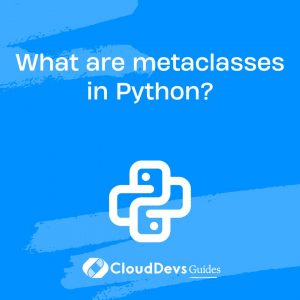What are metaclasses in Python?
At a high level, metaclasses in Python are a deep aspect of the language’s object-oriented model. They’re best understood by first recognizing that, in Python, everything is an object, including classes themselves. So, if classes are used to create objects, then what is used to create classes? The answer is metaclasses.
- Basic Concept:
Metaclasses are often described as “classes of classes.” While regular classes define the behavior of instances (objects created from the class), metaclasses define the behavior of classes themselves. Essentially, they control the class creation process, allowing you to customize how classes get constructed and how their attributes are initialized.
- Common Use Cases:
Metaclasses might seem abstract, but they have practical applications. They can be used to ensure coding standards (e.g., enforcing naming conventions for class attributes), auto-generating code (like ORM frameworks that generate database access methods), or introducing design patterns (like the Singleton pattern).
- The `type` Function:
In Python, the built-in `type` function acts as a metaclass. It’s responsible for producing new classes. While `type` can be used in a direct fashion to create classes, metaclasses are typically defined as subclasses of `type` to introduce custom behavior.
- Specifying a Metaclass:
In Python, you assign a metaclass to a class using the `metaclass` keyword in the class definition. Once specified, the metaclass will control the class’s creation and initialization.
- A Word of Caution:
While metaclasses are powerful, they can make code harder to understand, especially for developers unfamiliar with the concept. They should be used judiciously, only when their benefits clearly outweigh the added complexity.
IMetaclasses in Python provide a mechanism to influence and customize class creation. They’re a testament to Python’s deep commitment to object-oriented programming, allowing developers to modify even fundamental aspects of the language’s behavior. While they’re not commonly used in everyday coding, understanding metaclasses can help developers appreciate Python’s flexibility and the intricacies of its object model.







